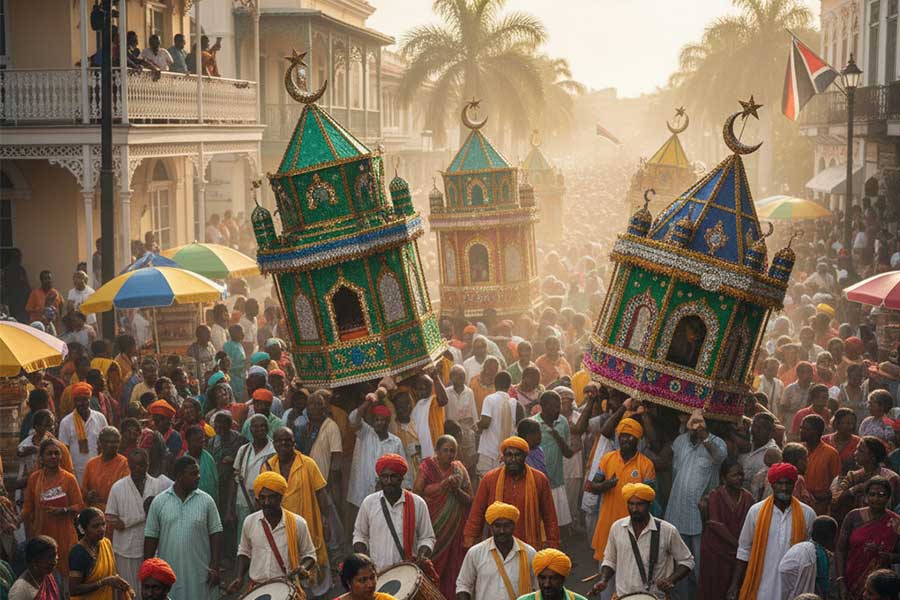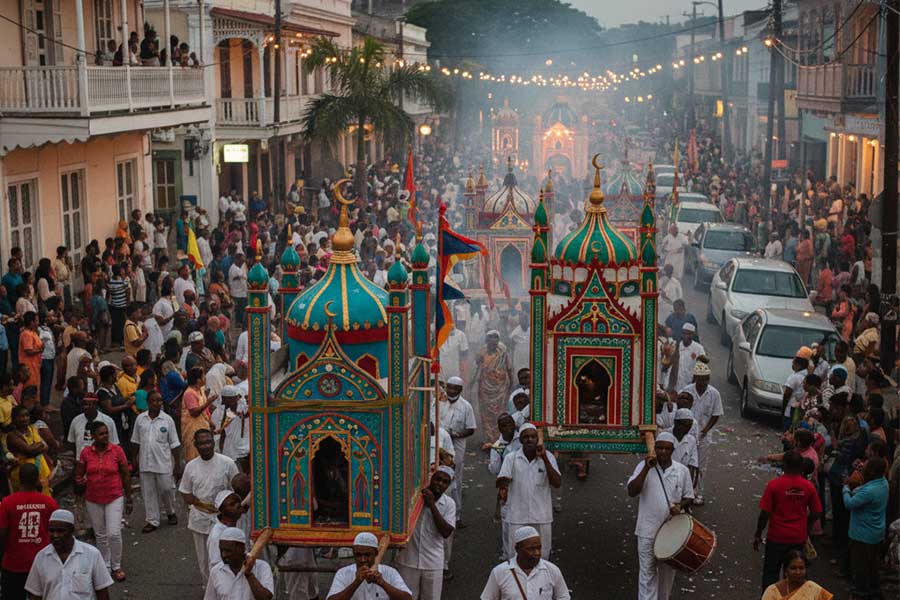As millions of American Muslims ushered in the new Islamic year with the start of Muharram, many prepared to fast on the Day of Ashura, reflecting on two significant events – the deliverance of Prophet Moses (peace be upon him) and the Israelites from Pharaoh, and the martyrdom of Hussain ibn Ali, beloved grandson of Prophet Muhammad (peace be upon him), in the tragic Battle of Karbala. For Muslims, Ashura is a day marked by both solemn remembrance and spiritual reflection. While joy is expressed in recalling Allah’s miracle, deep sorrow also echoes in hearts remembering the sacrifices made by the Prophet’s family, his Ahl al-Bayt. Though Sunni and Shia Muslims may differ in various theological and historical perspectives, Ashura remains a day of profound relevance for both communities, symbolizing steadfast faith, resistance to oppression, and divine justice.
South of the U.S. border, in countries such as Trinidad, Guyana, Jamaica, and Suriname, an eye-catching public celebration unfolds during this sacred time, one with its roots in Islamic history. Known as Hosay, a localized rendering of “Hussain,” this 10-day commemoration culminates in vibrant street processions featuring towering, colorful floats called tadjahs, theatrical reenactments, rhythmic drumming, and striking costumes. While some may dismiss Hosay as a mere cultural display, its origins lie in a spiritual mourning tradition brought by Indian Muslim migrants. Within the dazzling tapestry of Caribbean and South American culture, Hosay represents a powerful yet overlooked legacy of Islamic devotion and resilience in the heart of that region.
 A Forgotten History
A Forgotten History
This story dates back to the mid-19th century, when the abolition of slavery in British colonies in 1834 led to the establishment of a new labor system based on indentureship. Between 1845 and 1917, hundreds of thousands of laborers from British India, including Hindus and Muslims, were brought to work in colonies in the Caribbean and South America. This migration marked a third wave of Muslims entering the Americas, the first two being Spanish Moriscos and enslaved West Africans. These migrations helped shape the diverse and dynamic Muslim identity that continues to thrive in the Americas, despite centuries of displacement and colonialism. According to some accounts, about one-fifth of British Indian indentured workers were Muslim1. Indian Muslims brought traditions like Ashura processions with them to Caribbean and South America, which, over time and under colonial pressures, transformed into the uniquely syncretic festival now known as Hosay.
Across the Caribbean and parts of South America, Indian communities not only brought manpower but also a thriving cultural legacy that transformed colonial societies. Indian Muslims and Hindus lived side by side, finding more unity in their shared ethnic identity than division through religious difference. They also lived among formerly enslaved Africans, Indigenous peoples, and European colonizers, creating a layered social fabric shaped at times by cooperation, resistance, or negotiation under colonial rule. As historians note, “Hindustani” became the common designation for people of Indian descent2, regardless of their religious affiliation, to differentiate them from other groups. While moments of religious tension did occur among Muslims and Hindus from the Indian subcontinent, ethnic solidarity, a common language, and collective experience under indentureship easily bridged those divides.
These Hindustani communities, found in places like Trinidad, Guyana, Jamaica, and Suriname, have preserved their distinct traditions while reimagining them in their new lands, creating hybrid religious and cultural expressions shaped by their diverse experiences. Nowhere is this more visible than in the celebration of Hosay, which originated from the Islamic observance of Ashura and the mourning of Hussain ibn Ali and his family, but eventually absorbed elements from Hindu rituals and African diasporic spiritual practices. The rhythmic drumming and processions bear resemblance to Yoruba-influenced ceremonial music, while the ornate tadjahs, which are no more than towering, vibrant replicas of mausoleums, draw inspiration from Islamic architecture and local artistic traditions. Over time, colonial authorities began to flatten these layered expressions under the simplistic label of “Indian culture,” ignoring their deeper spiritual meanings and cross-religious influences.
What makes Hosay especially compelling is its capacity to transcend sectarian and ethnic boundaries. Though it began as a commemoration observed by both Sunni and Shia Muslims, it quickly evolved into a broader symbol of resistance, unity, and cultural pride. In Trinidad, when British colonial authorities attempted to ban the 1884 Hosay procession in San Fernando, the community responded with a peaceful protest. However, it ended in tragedy with the Hosay Massacre, where troops opened fire on the crowd, killing at least 22 people. From that moment forward, Hosay came to represent more than the martyrdom of Hussain and the Ahl al-Bayt; it also became a tribute to the sacrifices of those who stood against oppression and cultural erasure. Across the Caribbean, Hosay continues to thrive as a vibrant, inclusive celebration that unites people of various faiths and backgrounds in remembrance, resilience, and shared heritage.
Hosay as Islamic Heritage
Today, Hosay celebrations continue to take place each year in various parts of Trinidad, Guyana, Suriname, and even in pockets of Jamaica. The festival has become an integral part of the national pride in many of these countries, embraced not only by Indian-descended Muslims and Hindus but also by Afro-Caribbean and Christian communities. The elaborate tadjahs are built anew each year and carried through the streets to the beat of tassa drums, culminating in a symbolic immersion in the sea. Thousands watch the spectacle, regardless of their religious background.
Unfortunately, as with many long-standing traditions that have survived displacement and colonialism, Hosay has absorbed elements over the years that may not align strictly with Islamic law, including rituals borrowed from other religions like Hinduism and participation by non-Muslim faith groups. However, these additions do not erase the fact that Hosay’s origins lie firmly in Islamic memory, honoring the family of Prophet Muhammad (peace be upon him), and the values of sacrifice, resistance to tyranny, and fidelity to faith. The transformation of this tradition is not unique; it mirrors what has happened with other diasporic religious practices that adapt to survive. It also serves as a stark reminder that holding firmly to one’s religious principles is vital to preserving faith and identity across generations.
The presence of Hosay in the Caribbean and South America is not a coincidence; it is a living testimony to the presence of Islam across the globe, brought by enslaved Muslims and indentured Muslims who continued to express their faith, often under oppressive colonial rule. It is crucial, especially for Muslims living in the West, to understand and honor this layered history. These cultural relics stand as a testament to the fact that Islam in the Americas is not new, nor is it limited to one ethnic group or narrative. Presently, there are Muslims of all backgrounds in this vast region, including Indigenous peoples of those lands, as well as descendants of enslaved Africans and various immigrant communities who have embraced Islam across generations. Recognizing traditions like Hosay allows us to deepen our appreciation of Islam’s global diversity and reinforces the fact that our history is rich, complex, and worthy of preservation.
- Maria Del Mar Logroño Narbona, Paulo G. Pinto, and John Tofik Karam, Crescent Over Another Horizon: Islam in Latin America, the Caribbean, and Latino USA (University of Texas Press, 2015).
- Alexander Rocklin, The Regulation of Religion and the Making of Hinduism in Colonial Trinidad, 2019.




